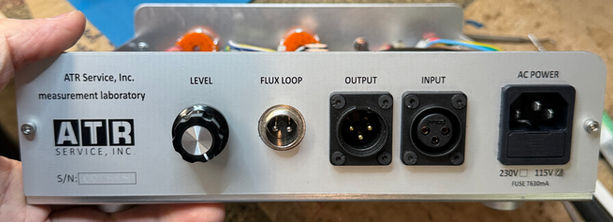
MFS-3 MAGNETIC FLUX SYSTEM


INTRODUCING OUR NEW PRODUCT
MFS-3 Magnetic Flux System
The MFS-3 Magnetic Flux System is a precision calibration tool designed to work with a specially engineered flux loop. Together, they enable accurate alignment of any reel-to-reel or cassette tape reproducer or recorder.
The MFS-3 supplies the necessary driving voltage and equalization for the flux loop, which in turn generates a calibrated magnetic field of known amplitude. This allows for precise adjustment and verification of playback equalization—without the need for a calibration tape.
Flux loops are available in a variety of sizes to fit different head geometries and tape formats.



scroll down for Q & A's
Could you please explain the advantage of having the flux loop.
Absolutely—I'd be happy to explain the vital role of using a Flux Loop instrument in the calibration process.
In analog recording and reproduction, the number one rule is to ensure your equipment is calibrated in terms of level and frequency response, according to the IEC-94.2 standard ("Calibration Tapes"). Unfortunately, the art of calibration has largely been forgotten, and that has a significant impact on the quality of the final audio product.
To achieve optimal performance, I recommend a two-step calibration process:
-
Use of a Flux Loop (fundamental for electronics alignment)
-
Use of a Reference Calibration Tape (to verify mechanical and head-related performance)
What is Flux Loop Alignment?
Flux loop alignment involves using a known, calibrated magnetic field—instead of a recorded tape signal—to align the playback electronics and head system. It simulates the signal a playback head would read from tape, but without needing to run the tape.
Key Advantages of Flux Loop Alignment:
-
Tape-Free Calibration
-
No need for physical calibration tapes, which:
-
Wear out
-
Can degrade over time
-
May vary from batch to batch
-
-
Reduces mechanical wear on your machine.
-
-
High Repeatability and Consistency
-
The signal is electronically generated with high precision.
-
Enables consistent, repeatable calibration every time.
-
-
Simplified and Faster Alignment
-
No need to load and run tape or measure physical tones manually.
-
Streamlines the calibration process, saving time during service.
-
-
Precise Electronic EQ Tuning
-
Directly injects a known signal into the head’s magnetic gap.
-
Ideal for fine-tuning EQ networks and playback frequency response.
-
Removes tape-related variables like flutter, wow, or dropouts.
-
-
Non-Destructive Testing
-
Avoids risk of damaging valuable reference tapes.
-
Particularly useful for vintage or fragile machines.
-
-
Playback Head Response Characterization
-
Accurately measures the magnetic sensitivity of playback heads.
-
Excellent for quality control or evaluating re-lapped heads.
-
Typical Use Cases:
-
Maintenance and alignment of mastering machines (e.g., Ampex ATR series)
-
Calibration of custom or tube-based playback electronics
-
Test labs or archival restoration facilities
-
Tuning of aftermarket tape head preamps
Our Magnetic Flux System MFS-3 generates a calibrated magnetic signal directly at the playback head, letting you align EQ precisely as though you're reading a real tape—with known flux density and frequency characteristics.
My Recommended Approach:
I always start with the Flux Loop to align the playback electronics to a flat frequency response.
Only then do I use the Reference Calibration Tape—which reveals the true condition of the playback head.
Here’s what to look for:
-
(a) Loss of High Frequencies:
This may result from a worn or re-lapped head. Compensating electronically will increase both the HF and noise floor—a compromise in quality. -
(b) Excessive Low Frequencies (Fringing Effect):
The head picks up LF content before the signal reaches the gap, causing a bump at 50–100 Hz—often 2–3 dB or more. If you compensate by reducing LF EQ, you might inadvertently create a bass roll-off starting at 200–300 Hz—which is not a true reflection of the tape, but a side effect of fringing.
Final Thoughts:
Flux loop alignment is an essential tool for achieving true, repeatable calibration and optimizing the performance of your analog system. It's not a replacement for calibration tapes—but the foundation that makes their results meaningful.
